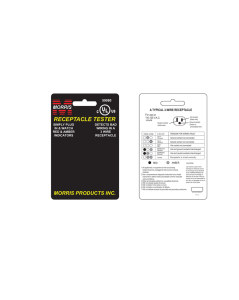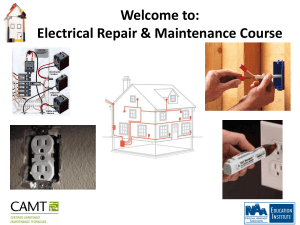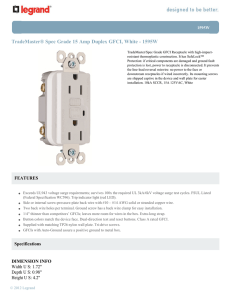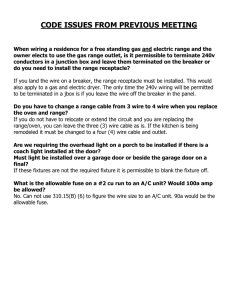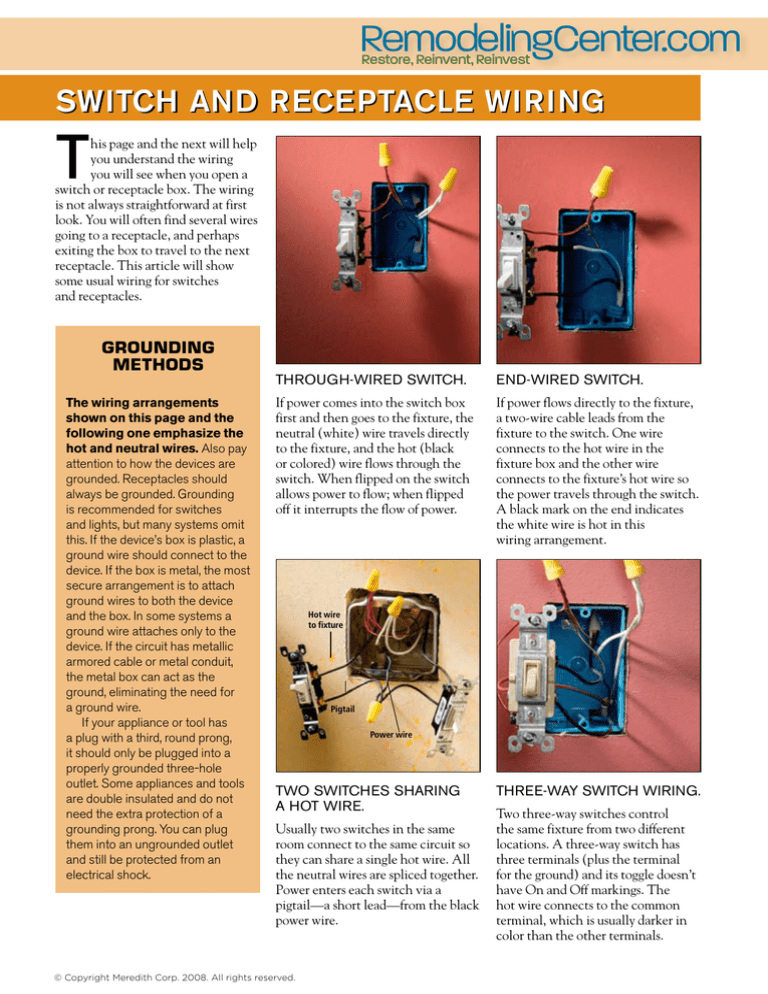
RemodelingCenter.com
Restore, Reinvent, Reinvest
switch and receptacle wiring
T
his page and the next will help
you understand the wiring
you will see when you open a
switch or receptacle box. The wiring
is not always straightforward at first
look. You will often find several wires
going to a receptacle, and perhaps
exiting the box to travel to the next
receptacle. This article will show
some usual wiring for switches
and receptacles.
Grounding
Methods
The wiring arrangements
shown on this page and the
following one emphasize the
hot and neutral wires. Also pay
attention to how the devices are
grounded. Receptacles should
always be grounded. Grounding
is recommended for switches
and lights, but many systems omit
this. If the device’s box is plastic, a
ground wire should connect to the
device. If the box is metal, the most
secure arrangement is to attach
ground wires to both the device
and the box. In some systems a
ground wire attaches only to the
device. If the circuit has metallic
armored cable or metal conduit,
the metal box can act as the
ground, eliminating the need for
a ground wire.
If your appliance or tool has
a plug with a third, round prong,
it should only be plugged into a
properly grounded three-hole
outlet. Some appliances and tools
are double insulated and do not
need the extra protection of a
grounding prong. You can plug
them into an ungrounded outlet
and still be protected from an
electrical shock.
Through-wired switch.
End-wired switch.
If power comes into the switch box
first and then goes to the fixture, the
neutral (white) wire travels directly
to the fixture, and the hot (black
or colored) wire flows through the
switch. When flipped on the switch
allows power to flow; when flipped
off it interrupts the flow of power.
If power flows directly to the fixture,
a two-wire cable leads from the
fixture to the switch. One wire
connects to the hot wire in the
fixture box and the other wire
connects to the fixture’s hot wire so
the power travels through the switch.
A black mark on the end indicates
the white wire is hot in this
wiring arrangement.
Hot wire
to fixture
Pigtail
Power wire
Two switches sharing
a hot wire.
Usually two switches in the same
room connect to the same circuit so
they can share a single hot wire. All
the neutral wires are spliced together.
Power enters each switch via a
pigtail—a short lead—from the black
power wire.
© Copyright Meredith Corp. 2008. All rights reserved.
Three-way switch wiring.
Two three-way switches control
the same fixture from two different
locations. A three-way switch has
three terminals (plus the terminal
for the ground) and its toggle doesn’t
have On and Off markings. The
hot wire connects to the common
terminal, which is usually darker in
color than the other terminals.
RemodelingCenter.com
Restore, Reinvent, Reinvest
Switch and receptacle wiring
(continued)
Mid-run receptacle.
End-run receptacle.
Split Receptacle.
If two cables enter a receptacle box,
one brings power to the receptacle
and the other leads out to receptacles
down the line. This is a mid-run
receptacle. The two neutral wires
connect to the neutral (silver)
terminals, and the two black wires
connect to the hot (brass) terminals.
If only one cable enters a receptacle
box, the receptacle is at the end of
the run. Connect the white wire
to the neutral (silver) terminal
and the black wire to the hot
(brass) terminal.
When two hot wires run to the hot
(brass) terminals, and the connecting
tab between the two has been broken
off, the receptacle is split. Either (1)
the receptacle’s two outlets are each
on a separate circuit so you can plug in
two high-amperage appliances without
overloading either circuit; or (2) the
receptacle is split and switched, meaning one of the outlets is controlled by a
wall switch somewhere in the room.
other wiring you
might find
Wire colors.
A different color hot wire designates
each circuit in homes that use wires
in conduit rather than cable. This
can help identify the circuit. If,
for instance, a device is connected
to a blue wire, look for a blue wire
in the service panel to find the
corresponding circuit breaker. Verify
that the breaker does shut off the
device before doing any work.
Receptacle that
branches out.
If three cables enter a box and all
the wires connect to the receptacle,
then it is a mid-run receptacle that
provides power for another branch or
fixture. In other words, power leaves
the receptacle in two directions. The
extra wires should be connected via
pigtails; it is not safe to attach two
wires to a single terminal.
© Copyright Meredith Corp. 2008. All rights reserved.
Red and black wires.
Sometimes a single three-wire
cable—with a red, black, and white
wire—is used to wire two different
circuits. The red wire is the hot wire
for one circuit, and the black is the
hot wire for the other circuit. The
white wire is used as a neutral for
both circuits.
A receptacle with two hot
wires. When two black wires or a
black one and a red one connect
to the two brass (hot) terminals,
the receptacle is split. Either each
of its two outlets is connected to
a different circuit, or one outlet is
controlled by a wall switch and the
other is always hot.
Wires that travel through. If
wires travel through a box but are
not connected to the box’s device
or fixture, they probably are for a
different circuit.

